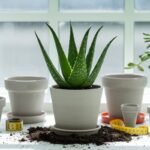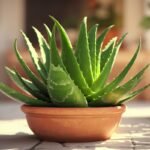Aloe Vera Indoor Care During Winter
Less is more with winter aloe care. Water much less frequently. Let the soil dry out completely between waterings. A bright spot is good, but avoid direct hot sunlight which can scorch even in winter. Cool temperatures are fine, just keep it above freezing. Don’t feed it at all during the cold season. Your aloe will appreciate the rest.
Signs of overwatering: Mushy leaves, yellowing, and a generally unhappy plant. Remedy: Hold back on the water! Less frequent watering is key to happy winter aloe.
Aloe Vera Winter Care Indoor: Why It’s Important for Plant Health
Keeping your aloe vera thriving indoors during winter can feel a bit tricky. It’s a different ball game compared to the summer months. With shorter days and less sunlight, your aloe vera needs a little extra TLC. This is where understanding aloe vera winter care indoors comes in. Proper care can be the difference between a healthy plant and one that struggles through the cold season. We’ll walk you through how to adjust your routine to help your aloe vera flourish inside until spring.
How to Keep Your Aloe Thriving Inside This Winter
Winter can be tough on aloe vera plants used to warm sunshine. Inside your home, they need a little extra attention to stay healthy. Let’s look at some simple ways to keep your aloe happy all winter long.
First, think about water. Aloe doesn’t need much in winter. Wait until the soil is completely dry before you water it again. Then, give it a good soak, but make sure any extra water drains away. Soggy soil can cause root rot, which is bad news for your plant.
Next, consider temperature. A cool room is best – think around 55 to 65 degrees Fahrenheit. Keep your aloe away from drafty windows and doors, and definitely off cold floors. A little chill can damage the leaves.
Sunlight is also key. Even in winter, aloe needs bright light. A south-facing window is ideal. If you don’t have a good sunny spot, a grow light can help supplement the natural light.
Finally, resist the urge to repot your aloe in winter. It’s best to let it rest. Spring is a much better time for repotting. With these easy steps, you can help your aloe vera plant weather the winter and be ready to grow again in spring.
Aloe Vera Plant Care Indoors During Winter
Keeping your aloe vera happy indoors during winter takes a little extra attention. Think of it like giving your plant a cozy winter vacation inside. Since it’s colder and darker outside, your aloe’s needs shift a bit. With the right approach, your plant can sail through winter looking its best.
First off, growth slows down a lot. It’s normal for your aloe to seem a bit sleepy during winter. It’s not actively growing new leaves, so it doesn’t need as much water or food. Overwatering is a big risk this time of year, as the soil stays damp longer. Let the soil dry out completely between waterings. You might only need to water once a month, or even less.
Sunlight is also less intense in winter. A south-facing window is usually the best spot for your aloe to soak up whatever sun is available. Even with a good spot, supplemental light can make a difference, especially if you notice your plant getting a bit pale or stretched out. A simple grow light can help keep it happy.
Finally, keep your aloe away from cold drafts and windows that get frosty. Cold temperatures can damage the leaves. Aim for a consistent temperature; a typical room temperature is just fine. With these simple adjustments, your aloe vera can stay healthy and get ready for a burst of growth when spring arrives.
Aloe Vera Watering Schedule in Winter
Let’s talk about watering your aloe vera in the winter. It’s different than the summer months. Remember how often you watered it during the warm season? Well, you’ll want to cut back quite a bit. Aloe vera doesn’t need nearly as much moisture when it’s cold.
Think of it this way: aloe vera winter care indoor means less frequent watering. The soil should dry out completely between waterings. How can you tell? Stick your finger a couple of inches into the pot. If it feels dry, you’re good to go. If it feels at all damp, wait a bit longer.
Overwatering is a real danger in winter. Soggy soil can lead to root rot, which is bad news for your plant. It’s much better to underwater than to overwater when it comes to aloe vera winter care. So, err on the side of caution.
The frequency of watering will depend on factors like the size of your pot, the type of soil, and the humidity in your home. You might only need to water your aloe once every few weeks, or even less. Just pay attention to how dry the soil is, and that’ll be your best guide for when to water.
When you do water, give it a good soak, ensuring the water drains out of the drainage holes. Don’t let the pot sit in standing water. And, of course, use room temperature water – cold water can shock the roots during indoor aloe vera plant care winter.
Following these simple aloe vera watering schedule winter tips will help your plant stay healthy and happy all winter long.
Optimal Winter Temperature for Aloe Vera Indoors
Keeping your aloe vera happy indoors during winter mostly comes down to temperature. Think about where aloe vera naturally grows – warm, sunny spots. You want to mimic that inside your home as much as possible. A good range to aim for is between 50 and 80 degrees Fahrenheit. Anything below 50, and you risk chilling your plant. Too high above 80, and it might dry out quicker than you’d like.
Now, homes can have temperature swings, especially in winter. Near a window can get colder at night, and areas near heating vents can get quite warm. Just be mindful of these hotspots and cool spots. You want to find a location that stays relatively stable within that ideal temperature range. A consistent temperature helps your aloe vera avoid stress, which can make it more vulnerable to problems.
Aloe vera winter care indoor involves paying close attention to these seemingly small details. If you can keep the temperature right, you’ve already won half the battle in ensuring your aloe vera thrives throughout winter.
Aloe Vera Light Requirements: Ensuring Adequate Sunlight in Winter
Sunlight changes during winter. It’s weaker, and the days are shorter. This can be tough on an aloe vera plant used in brighter conditions. Let’s look at how to make sure your aloe gets the light it needs to stay healthy indoors during the winter.
A south-facing window is often the best spot for your aloe in winter. It gets the most direct sunlight. If you don’t have a south-facing window, an east or west-facing one will work, but you might need to add some extra light.
Think about how much light your plant is getting. Is there anything blocking the window, like a tree or building? Even a sheer curtain can reduce the light reaching your aloe.
You’ll want to keep an eye on your aloe. If it starts to stretch out or become pale, that’s a sign it’s not getting enough light. This leggy growth is the plant’s way of trying to reach for more sun.
If your aloe isn’t getting enough natural light, a grow light can help. These lights supplement natural sunlight, giving your plant the boost it needs. There are many different types of grow lights available, so you can find one that fits your space and budget.
Remember to rotate your plant every few weeks. This ensures even light exposure on all sides, preventing it from leaning towards the light source and promoting balanced growth. Just a quarter turn each time is enough.
With a little attention to its light needs, your aloe vera can thrive indoors all winter long, even when the sun isn’t at its strongest. Paying attention to these simple tips for aloe vera winter care indoor will keep your plant healthy and happy.
Choosing the Best Place for Aloe Vera Indoors During Winter
Finding the right spot in your home for your aloe vera during winter is key to its well-being. Think of it like finding the perfect cozy spot for yourself on a cold day! You want it to be comfortable and just right.
A south-facing window is usually ideal. This lets your aloe get the most sun, even on shorter winter days. Aloe vera winter care indoor involves making sure it gets enough light.
If a south-facing spot isn’t available, an east or west-facing window might work. Keep a close eye on your plant. If it looks like it isn’t getting enough light (if it seems to be stretching out or becoming pale), you might need to supplement it with a simple grow light. Just a few hours of extra light can make a big difference in your plant’s winter health.
Avoid putting your aloe vera near drafty windows or doors. Cold blasts of air can shock the plant and cause problems. Similar to how you wouldn’t want to sit in a draft, your aloe won’t either. Aloe vera winter care indoor also means protection from cold drafts.
Also, keep it away from radiators or heating vents. These can dry out the air and your aloe quickly, causing the tips of the leaves to turn brown and crispy. A bit of humidity is beneficial, so if your home is very dry, a simple tray of pebbles with water beneath the pot can help create a more comfortable environment. This addresses a specific part of aloe vera winter care indoor that many people overlook. Keep in mind, though, not to let the pot sit directly in the water; this can lead to root rot.
By paying attention to these little details, you can help your aloe vera thrive all winter long. It’s all about creating an environment that replicates the sunny, warm conditions it prefers. With the right aloe vera winter care indoor, your plant will be healthy and happy until spring arrives.
Understanding Aloe Vera Dormancy in Winter and What It Means
Just like many other plants, aloe vera can enter a period of dormancy during the winter months. This is a natural response to shorter days and cooler temperatures. Don’t panic if your aloe vera seems to slow down its growth or even stop producing new leaves during this time – it’s perfectly normal.
Aloe vera dormancy essentially means the plant is conserving its energy. Think of it like a little winter hibernation. It’s not dead or dying; it’s just resting. This dormant period allows your aloe vera to survive the less-than-ideal winter conditions and be ready to thrive again when spring arrives.
During aloe vera winter care indoor, understanding dormancy is crucial. Because the plant isn’t actively growing, its needs change. You’ll need to adjust your aloe vera watering schedule winter and be extra mindful of not overwatering. Soggy soil during dormancy can lead to root rot, one of the biggest threats to indoor aloe vera plant care winter.
So, what does dormancy mean for your aloe vera winter care routine? It means less is more. Less water, less fertilizer (none at all is best), and a cooler location within your home are ideal. By recognizing and respecting this dormant period, you’re helping your aloe vera conserve its strength and prepare for a healthy and vigorous growing season come spring. This is key to achieving a successful winter aloe vera light requirements strategy as well. A dormant plant requires less sunlight, so don’t worry if your indoor space isn’t as bright during the winter months.
Protecting Aloe Vera from Cold and Frost
Your indoor aloe vera is sensitive to cold temperatures. Keep it away from windows and doors. A sudden cold can damage it, so think about where you put it.
If your aloe cools down too much, you may notice some changes. The leaves may be soft or dry. It’s a sign of anxiety. Move your plant to a warm place immediately.
Even indoors, chills can be a problem if the temperature drops significantly. Make sure your aloe vera is in a permanently warm area of your home during the winter.
Think of your aloe vera as a person who likes to be comfortable. It wants a stable, warm environment, especially in winter. Keep him happy by providing that warmth.
Aloe Vera Winter Care Indoor is all about protecting your plant from the cold. By making sure it stays warm and away from draughts, you give it the best chance to thrive in the winter months.
Common Winter Problems with Aloe Vera and How to Solve Them
Even with the best intentions, your aloe vera might encounter a few hiccups during winter. Let’s look at some common issues and how to address them.
Root Rot
Overwatering is the biggest culprit behind root rot, especially in winter. Soggy soil and cold temperatures are bad for aloe vera’s roots. If the leaves become mushy, especially at the base, root rot might be the problem. Gently remove the plant from its pot and check the roots. Healthy roots are firm and white; rotting roots are brown and mushy. If you find root rot, trim the affected parts with a clean knife. Repot your aloe in fresh, well-draining soil and reduce watering frequency.
Leaf Browning/Tip Dieback
Dry air, underwatering, or cold drafts can cause leaf tips to brown and dry out. If the browning is limited to the tips, it’s usually not a major concern. Trim off the brown tips with clean scissors. Increase humidity around the plant by grouping it with other plants or placing it on a tray of pebbles and water (ensure the pot’s bottom doesn’t sit in the water). Adjust your watering schedule if the soil is too dry.
Pale or Yellowing Leaves
This could signal a lack of sunlight. Move your aloe to a brighter location, closer to a window. If natural light is scarce, consider using a grow light.
Pests
While less common in winter, pests can still be a nuisance. Inspect your aloe regularly for signs of insects. If you spot any, treat the plant promptly with an appropriate insecticide or natural pest control method.
Winter doesn’t have to be a stressful time for your aloe vera. By paying attention to its needs and addressing any problems promptly, you can help it thrive indoors until the warmer months return.






